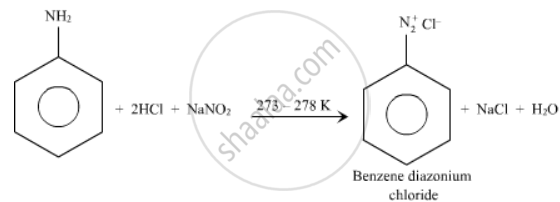Advertisements
Advertisements
प्रश्न
Illustrate the following reaction giving suitable example in each case: Diazotisation
Write the reactions involved in Diazotisation
उत्तर १

उत्तर २
The process of the formation of the diazonium salt by the reaction of the aromatic amine with the nitrous acid is known as the diazotization reaction

APPEARS IN
संबंधित प्रश्न
Write equations of the following reactions:
Acetylation of aniline
Why is benzene diazonium chloride not stored and is used immediately after its preparation?
Predict the product of reaction of aniline with bromine in non-polar solvent such as \[\ce{CS2}\].
Why is aniline soluble in aqueous HCl?
How will you carry out the following conversions?
toluene `->` p-toluidine
How will you carry out the following conversions?
p-toluidine diazonium chloride `→` p-toluic acid
Match the compounds given in Column I with the items given in Column II.
| Column I | Column II | ||
| (i) | Benzene sulphonyl chloride | (a) | Zwitter ion |
| (ii) | Sulphanilic acid | (b) | Hinsberg reagent |
| (iii) | Alkyl diazonium salts | (c) | Dyes |
| (iv) | Aryl diazonium salts | (d) | Conversion to alcohols |
A colourless substance ‘A’ \[\ce{(C6H7N)}\] is sparingly soluble in water and gives a water soluble compound ‘B’ on treating with mineral acid. On reacting with \[\ce{CHCl3}\] and alcoholic potash ‘A’ produces an obnoxious smell due to the formation of compound ‘C’. Reaction of ‘A’ with benzenesulphonyl chloride gives compound ‘D’ which is soluble in alkali. With \[\ce{NaNO2}\] and \[\ce{HCl}\], ‘A’ forms compound ‘E’ which reacts with phenol in alkaline medium to give an orange dye ‘F’. Identify compounds ‘A’ to ‘F’.
Aniline when treated with cone. HNO3 gives
Benzene diazonium chloride is a ______.
